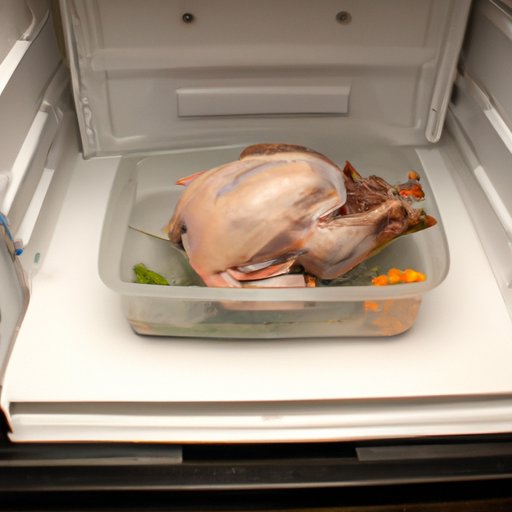
Introduction
Thanksgiving is the perfect time to enjoy delicious food and spend quality time with family and friends. One of the most essential components of a traditional Thanksgiving dinner is a beautifully roasted turkey. However, it’s important to follow proper procedures when thawing your turkey to ensure both safety and flavor.
In this article, we’ll provide you with a step-by-step guide to thawing a turkey safely and without a hitch. Whether you’re a seasoned pro or a novice cook, this guide will give you all the tips and tricks you need to make your Thanksgiving turkey the star of your holiday feast.
Benefits of Proper Turkey Thawing
While it may be tempting to take shortcuts when preparing your Thanksgiving meal, proper turkey thawing is crucial for both safety and flavor. According to the USDA, thawing your turkey at room temperature or in warm water can cause harmful bacteria to grow, putting you and your dinner guests at risk of food poisoning.
In addition to the health risks, improper thawing can also affect the taste and texture of your turkey. Freezing and thawing can cause ice crystals to form in the meat, which can make it tough and dry. By following the steps outlined in this guide, you’ll not only ensure the safety of your guests but also guarantee a juicy, flavorful turkey.
Step-by-Step Guide to Thawing a Turkey in the Refrigerator
The safest and most recommended way to thaw your turkey is in the refrigerator. Here’s a step-by-step guide to thawing your turkey safely in the refrigerator:
1. Plan Ahead: Allow enough time to thaw your turkey based on its weight. A general rule of thumb is to allow 24 hours of thawing time for every 4-5 pounds. For example, a 20-pound turkey will need at least 4-5 days to thaw in the refrigerator.
2. Clean and Organize: Before placing your turkey in the refrigerator, make sure the fridge shelves are clean and clear of any other items that could contaminate your turkey.
3. Remove Packaging: Take the turkey out of its packaging and remove the neck and giblets from the cavity, if necessary. You can store these in a separate container or discard them.
4. Place on a Tray: Place the turkey upside down in a roasting pan or on a tray to catch any juices.
5. Cover and Refrigerate: Cover the turkey with plastic wrap or aluminum foil and place it in the coldest part of your refrigerator until it’s fully thawed.
Alternative Methods to Thaw a Turkey
If you don’t have the time to thaw your turkey in the refrigerator, there are alternative methods you can use. However, it’s important to note that these methods carry a higher risk of foodborne illness and may affect the flavor and texture of your turkey.
Cold Water Bath
To thaw your turkey using the cold water bath method, follow these steps:
1. Fill a large container with cold water. Make sure the water is no warmer than 40°F.
2. Take the turkey out of its packaging and remove the neck and giblets from the cavity, if necessary.
3. Place the turkey in the water, making sure it’s fully submerged.
4. Change the water every 30 minutes to keep it cold.
5. Once the turkey is fully thawed, cook it immediately.
Microwave
Using the microwave method is the quickest way to thaw your turkey, but it’s also the most difficult to control. Here’s what you need to do:
1. Check the turkey manufacturer’s guidelines for microwave thawing times and power.
2. Remove the turkey from its packaging and place it on a microwave-safe dish.
3. Microwave the turkey based on the manufacturer’s guidelines.
4. Once the turkey is fully thawed, cook it immediately.
Common Mistakes to Avoid
Here are some of the most common mistakes people make when thawing their turkey and how to avoid them:
– Leaving the turkey out on the counter: This can attract harmful bacteria. Always thaw your turkey in the refrigerator or using a safe alternative method.
– Rinsing the turkey: Rinsing the turkey can spread bacteria around your kitchen. Instead, remove the neck and giblets and pat the turkey dry with paper towels.
– Not leaving enough time to thaw: Don’t wait until the last minute to start thawing your turkey. Plan ahead and allow enough time for it to thaw safely.
Preparing and Cooking Your Turkey
Once your turkey is fully thawed, it’s time to prepare and cook it. Here are some tips to ensure the best results:
– Preheat your oven to 325°F.
– Season your turkey with your favorite spices and herbs.
– Place your turkey on a roasting rack in a roasting pan.
– Add some liquid, such as chicken broth or white wine, to the bottom of the pan to keep the turkey moist.
– Calculate the cooking time based on the size of your turkey. A general rule of thumb is to cook for 15 minutes per pound.
– Use a meat thermometer to check the temperature of your turkey. It should reach an internal temperature of 165°F in the thickest part of the meat.
Recipes and Meal Ideas for Using Leftover Turkey
If you have leftover turkey after your Thanksgiving feast, don’t worry! There are plenty of delicious recipes you can make with it, such as turkey pot pie, turkey soup, and turkey shepherd’s pie. Get creative and try new recipes to enjoy your turkey in different ways.
Fun Facts about Thanksgiving Turkey
– The average turkey has around 70% white meat and 30% dark meat.
– The turkey was never actually declared the official bird of Thanksgiving, although it’s become the most iconic dish.
– In 1953, Swanson’s introduced the world’s first TV dinner, featuring turkey, cornbread dressing, and gravy.
Conclusion
We hope this guide has been helpful in teaching you how to safely thaw and cook your Thanksgiving turkey. Remember to always take your time and follow proper procedures to ensure the best results.




